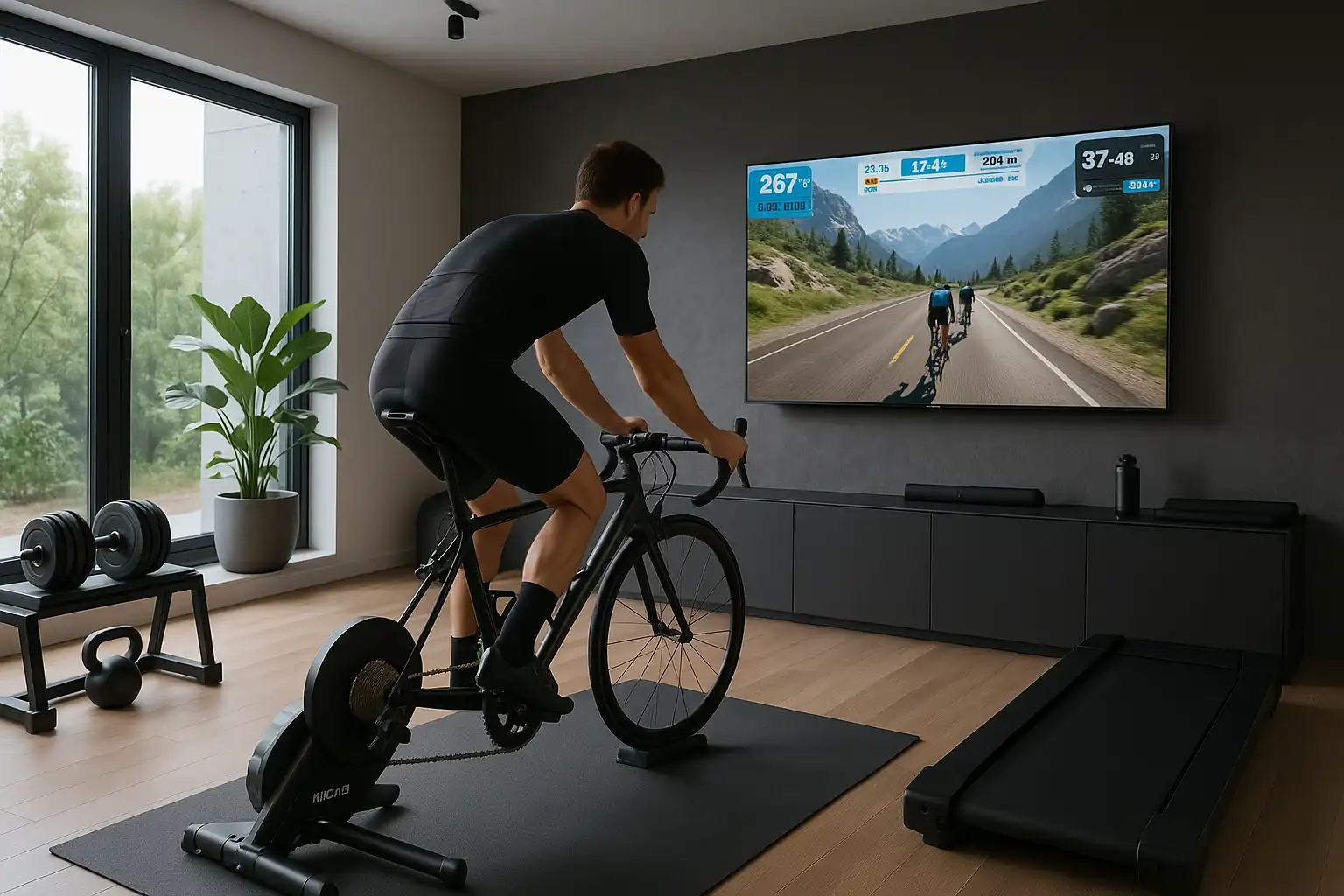Indoor cycling has undergone a remarkable transformation in 2025, evolving from simple stationary bikes to sophisticated training systems that provide immersive, interactive experiences rivaling outdoor cycling. The integration of smart technology, virtual reality, and social connectivity has created indoor cycling experiences that are engaging, effective, and accessible to cyclists of all levels.
The growth of indoor cycling has been accelerated by advances in trainer technology, the proliferation of virtual cycling platforms, and changing lifestyle patterns that prioritize convenience and flexibility in fitness routines. Modern indoor cycling systems provide training opportunities that would be impossible to replicate outdoors, including precise power control, structured workouts, and virtual group rides with cyclists from around the world.
## Smart Trainer Technology: Precision and Control
Smart trainers have revolutionized indoor cycling by providing precise control over resistance, accurate power measurement, and seamless integration with training software and apps. Modern smart trainers can simulate real-world riding conditions with remarkable accuracy, including gradients, road surfaces, and wind resistance.
Direct-drive trainers eliminate the rear wheel and connect directly to the bike’s drivetrain, providing the most accurate and realistic riding experience possible. These trainers offer precise power measurement, quiet operation, and the ability to simulate gradients up to 25% or more.
Wheel-on trainers provide a more affordable entry point to smart training while still offering many of the benefits of direct-drive systems. Modern wheel-on trainers feature improved accuracy, reduced noise, and better connectivity compared to earlier generations.
Resistance control in smart trainers can be managed automatically by training software or manually by the rider. Automatic control allows for structured workouts that adjust resistance based on training goals, while manual control provides flexibility for free-riding and custom workouts.
Power measurement accuracy in smart trainers has improved dramatically, with many models providing accuracy within 1-2% of laboratory-grade power meters. This precision enables effective power-based training and accurate performance tracking.
Connectivity features in smart trainers include ANT+, Bluetooth, and WiFi capabilities that allow seamless integration with multiple devices and platforms simultaneously. This connectivity enables riders to use their preferred training apps while tracking data on multiple devices.
## Virtual Cycling Platforms: Worlds Without Limits
Virtual cycling platforms have created immersive digital environments that make indoor training engaging and social. These platforms combine realistic graphics, accurate physics, and social features to create cycling experiences that rival outdoor riding in terms of engagement and motivation.
Zwift continues to lead the virtual cycling space with its gamified approach to indoor training. The platform features multiple virtual worlds, structured training programs, group rides, and competitive racing that keeps riders engaged and motivated throughout their indoor sessions.
Other platforms like TrainerRoad, Sufferfest, and Rouvy offer different approaches to virtual cycling, from structured training focus to real-world video integration. This diversity allows cyclists to choose platforms that match their training goals and preferences.
Social features in virtual cycling platforms enable riders to train with friends, join group rides, and participate in virtual events regardless of their physical location. These social connections help maintain motivation and create communities around indoor cycling.
Gamification elements like achievements, levels, and virtual rewards provide additional motivation for indoor training. These features help make structured training more engaging and provide goals beyond pure performance metrics.
Real-world integration features allow riders to virtually ride famous cycling routes and races from around the world. High-quality video and accurate elevation data create realistic experiences of iconic cycling destinations.
## Structured Training: Science-Based Performance
Indoor cycling provides ideal conditions for structured, science-based training that can be difficult to replicate outdoors. The controlled environment and precise power control enable training protocols that maximize performance gains while minimizing time investment.
Power-based training has become the gold standard for cycling performance development, and indoor trainers provide the perfect platform for implementing power-based training protocols. Precise power control allows for specific interval training that targets different energy systems and physiological adaptations.
Heart rate training remains important for many cyclists, and indoor environments provide consistent conditions for heart rate-based workouts. The absence of variables like wind, traffic, and terrain changes allows for more precise heart rate zone training.
Structured workout libraries in training platforms provide professionally designed workouts for different goals, fitness levels, and time constraints. These workouts are based on sports science research and coaching experience, providing effective training for cyclists who may not have access to professional coaching.
Training periodization is easier to implement with indoor cycling systems that can track long-term progress and adjust training loads based on performance data. Automated training plan adjustments help ensure that training remains effective and appropriate as fitness levels change.
Recovery and easy ride sessions are often more effective indoors, where riders can maintain precise intensities without the temptation to ride harder due to external factors like group dynamics or competitive instincts.
## Group Fitness: Community in Virtual Spaces
Indoor cycling classes and group fitness programs have evolved to incorporate technology and virtual elements while maintaining the motivational benefits of group exercise. Modern indoor cycling classes combine traditional group fitness energy with technological enhancements that improve the experience.
Virtual group rides allow cyclists to participate in group activities from their own homes, connecting with riders from around the world for shared training experiences. These virtual groups provide social interaction and motivation while offering flexibility in scheduling and location.
Instructor-led virtual classes combine the expertise of professional instructors with the convenience of home training. Live and on-demand classes provide structured workouts with professional guidance and motivation.
Competitive elements in group indoor cycling include virtual races, leaderboards, and challenges that add excitement and motivation to training sessions. These competitive features appeal to riders who thrive on competition and goal-oriented training.
Social features like chat, voice communication, and video integration help create community connections in virtual cycling environments. These features help replicate the social aspects of outdoor group rides in indoor settings.
## Health and Fitness Benefits: Maximizing Indoor Training
Indoor cycling provides unique opportunities for health and fitness development that can be difficult to achieve with outdoor cycling alone. The controlled environment and precise measurement capabilities enable targeted fitness development and health monitoring.
Cardiovascular fitness development is highly effective with indoor cycling, as riders can maintain precise intensities and durations that optimize cardiovascular adaptations. The ability to control all variables allows for consistent, progressive training that maximizes fitness gains.
Weight management benefits from indoor cycling include precise calorie tracking and the ability to maintain consistent exercise routines regardless of weather or schedule constraints. The convenience of indoor cycling helps maintain exercise consistency, which is crucial for weight management.
Low-impact exercise benefits make indoor cycling accessible to people with joint issues or injuries that might prevent other forms of exercise. The smooth, controlled motion of indoor cycling provides cardiovascular benefits without high-impact stress on joints.
Rehabilitation applications for indoor cycling include precise control over exercise intensity and duration, making it valuable for physical therapy and injury recovery programs. The ability to gradually increase intensity and monitor progress makes indoor cycling ideal for rehabilitation settings.
Mental health benefits of indoor cycling include stress reduction, mood improvement, and the social connections available through virtual platforms. The endorphin release from exercise combined with social interaction can provide significant mental health benefits.
## Technology Integration: The Connected Cycling Experience
Modern indoor cycling systems integrate with a wide range of devices and platforms, creating comprehensive fitness ecosystems that track, analyze, and optimize training and health data.
Smartphone and tablet integration allows riders to access training apps, entertainment content, and communication tools during indoor cycling sessions. Large screens and multiple device setups create immersive training environments.
Wearable device integration includes heart rate monitors, power meters, and fitness trackers that provide comprehensive data about training sessions and overall health metrics. This integration creates detailed pictures of fitness and performance trends.
Smart home integration allows indoor cycling systems to control lighting, temperature, and entertainment systems to optimize the training environment. Automated environmental controls can enhance comfort and performance during training sessions.
Data analysis and tracking capabilities in modern indoor cycling systems provide detailed insights into performance trends, training load, and fitness development. This data helps riders optimize their training and track progress toward goals.
Cloud-based data storage and analysis enable long-term tracking and comparison of training data across different platforms and devices. This comprehensive data management helps riders understand their fitness development over time.




